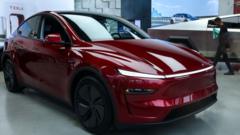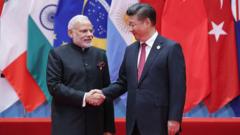With Tesla beginning its hiring process in India, the company faces the challenge of competing in a market dominated by lower-cost electric vehicles. The Indian market, known for its price sensitivity, presents hurdles in pricing, infrastructure, and road conditions, prompting questions about Tesla's potential success in the region.
Tesla's Challenge in Attracting India's Budget-Conscious Buyers

Tesla's Challenge in Attracting India's Budget-Conscious Buyers
As Tesla prepares to enter India's EV market, can its premium pricing strategy appeal to a price-sensitive consumer base?
Tesla has made strategic moves to establish itself in India's electric vehicle (EV) market, hiring for various positions in Delhi and Mumbai while scouting for showroom locations in both cities. However, the American EV manufacturer faces a pivotal challenge in winning over India's economically cautious buyers, especially in light of competitive pricing offered by domestic players.
Currently, Tata Motors reigns supreme in the Indian EV landscape, capturing over 60% of the market share, followed by MG Motors and Mahindra and Mahindra. Most local electric models boast prices significantly lower than Tesla's estimated base price of around $40,000 (£31,637), pushing Tesla toward a luxury segment in contrast to more budget-friendly alternatives. Consequently, the company's growth potential in India may be limited unless it introduces a more affordable vehicle tailored to local consumers.
Adding to the challenge, India’s road conditions could impede Tesla’s entry into the market, as their vehicles typically have low ground clearance. This may necessitate modifications for the Indian terrain, consequently raising manufacturing expenses. Hormazd Sorabjee, editor of Autocar India, noted that the engineering adjustments required for such adaptations could be a deterrence for a relatively small market presence.
Despite the odds, India's government has rolled out an ambitious plan to encourage EV adoption, aiming for significant percentages of electric vehicles across various segments by 2030. Additionally, domestic initiatives have led to outrageous growth in EV sales—rising from 4,700 vehicles in five years to over 100,000, incentivizing industry developments.
In an effort to entice foreign companies like Tesla, India has lowered import taxes for EVs over $35,000 (£27,550) that meet specific investment criteria. This move, however, raises concerns regarding the competitive landscape for local manufacturers, who emphasize the necessity of a level playing field.
As Tesla gears up for its anticipated entrance, the growing demand for premium vehicles among affluent Indians may offer some advantages. However, it remains uncertain when or if the company will commit fully to manufacturing within India, relying on international shipments in the meantime. Future strategies may be influenced by tariff negotiations with the US and whether foreign investment could spur domestic production for Tesla in India.
















